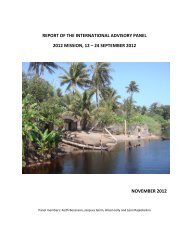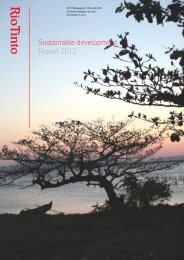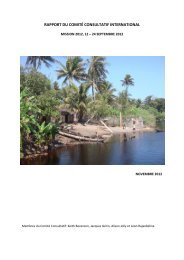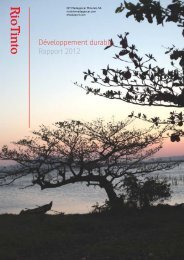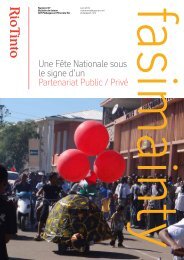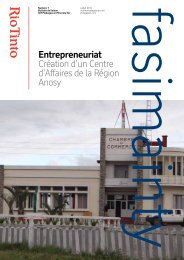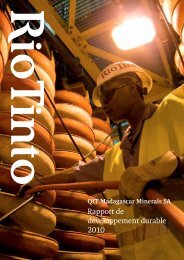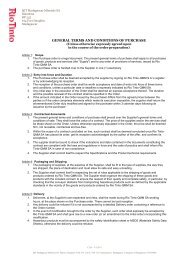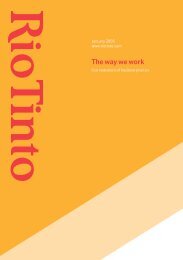Tracking Development - Rio Tinto - Qit Madagascar Minerals
Tracking Development - Rio Tinto - Qit Madagascar Minerals
Tracking Development - Rio Tinto - Qit Madagascar Minerals
Create successful ePaper yourself
Turn your PDF publications into a flip-book with our unique Google optimized e-Paper software.
The construction Phase<br />
stimulating Local Employment<br />
Although skilled positions were generally externally recruited,<br />
all unskilled or semi-skilled labour was recruited locally; of<br />
the 4,500 total jobs, 3,600 positions were filled by Malagasy<br />
people, of which 70 per cent were from the Anosy region.<br />
To prepare for the construction phase of the project, a<br />
qualitative aptitude test, the Dover test, was administered to<br />
interested local applicants. The test was conducted to screen<br />
and quantify available candidates above a certain threshold,<br />
assessing hand-eye coordination, short training time and<br />
retention of acquired skills over time. This enabled QMM to<br />
select the most suitable applicants and provide a pre-selected<br />
list of potential employees to contractors, ensuring effective<br />
and efficient local recruitment.<br />
A key challenge was the safety and training of employees,<br />
many of whom were farmers and fisherman who had<br />
never worked on a construction site before. This was done<br />
successfully, with over 14 months without a Lost Time Injury<br />
and the lowest All Industry Frequency Rate in the <strong>Rio</strong> <strong>Tinto</strong><br />
Group. As a result, the project was awarded the Chief Safety<br />
Award “in recognition of efforts taken to achieve outstanding<br />
safety performance and a sustaining safety culture.”<br />
Monitoring Inflation and Migration<br />
QMM is committed to mitigating any potential negative<br />
impacts its operations could have on the Anosy region.<br />
To manage inflation, QMM monitored the prices of major<br />
commodities in Fort Dauphin between 2005 and 2008<br />
through a contract with the Institut National de Statistique de<br />
<strong>Madagascar</strong> (INSTAT, or National Institute of Statistics). The<br />
changes in consumer prices in the region before and during<br />
construction were examined. Studies also compared prices in<br />
Fort Dauphin with those of other major cities in <strong>Madagascar</strong><br />
over a designated period of time. The data was then made<br />
available to partners and local NGOs. To improve the quality<br />
of information, QMM introduced a “mystery shopper”<br />
programme, whereby residents from Fort Dauphin’s poorest<br />
areas were given a small amount of shopping money once<br />
per week. Purchasing specific products from different<br />
markets, they reported the costs and kept the goods as<br />
compensation.<br />
Rice is the staple food and crop in <strong>Madagascar</strong>. During<br />
the lean season, typically from October to April, rice<br />
shortages have been recorded in Fort Dauphin. Recognising<br />
a population influx could have an effect on rice availability,<br />
QMM initiated a programme to stabilise the price of rice.<br />
Through meetings with stakeholders; affected households,<br />
local government members and regional authorities, a rice<br />
monopoly was discovered to exist in the region. QMM<br />
assembled and supported a group of local wholesalers and<br />
encouraged networking between the different entrepreneurs.<br />
Provisioning and logistical support was provided, including a<br />
storehouse. Working with a local bank, QMM supported<br />
the wholesalers in their microfinance initiatives and provided<br />
a letter of guarantee for the participants. As a result, the<br />
price of rice in the local markets fell by 15 per cent between<br />
January 2007 and January 2008.<br />
Despite numerous positive efforts undertaken, the price<br />
of certain staples and services, such as housing and many<br />
food products, inexorably climbed. This created tangible<br />
problems for those in the population who were not<br />
employed or indirectly benefiting from QMM, with the poor<br />
most heavily impacted. The influx of some available income<br />
also increased local inequality even as it benefited the many<br />
who were employed.<br />
27



